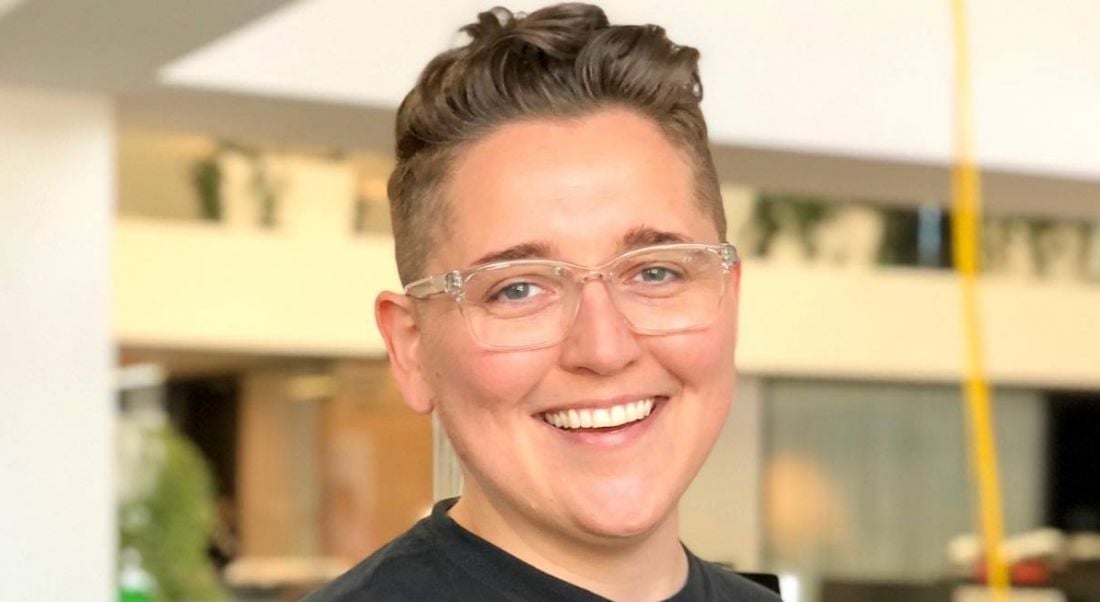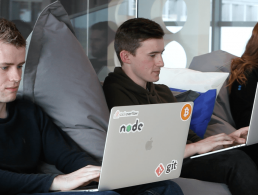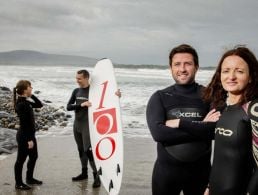Want to know the secrets to getting a job at Spotify? We heard how Sam Young came from investment banking and landed a dream role.
After college, I took a job at a bank because my adviser told me I would make a lot of money and it would look great on a résumé. I ended up being there more than six years – a lot longer than I originally planned.
I always knew that, as a queer feminist, I wasn’t on the same wavelength as most of the people that I worked with in banking. That was bearable for the first few years, but over time it wore me down.
Once I recognised that I was unhappy at the bank, I embarked on a year-long research project aimed at landing my dream job. What I discovered is, there are many paths – you just have to find yours. This was mine.
Two things you need to know first:
- I recognise my privilege – I’m a white English speaker, I have a bachelor’s degree from a college with name recognition, I live in New York and I have a spouse who had full-time employment. Changing careers was a lot easier for me than other people.
- There’s no one silver bullet to finding a dream job. You have to come at it from multiple levels simultaneously.
Six steps to Spotify
Step 1: Recognising why I wanted to change careers
I’m a queer, gender-nonconforming woman and am frequently mistaken for a man. This isn’t always terrible – surreptitiously getting the respect afforded to white men in our society obviously has its benefits.
But being misgendered in the women’s bathroom even after years of working in the same office made me feel deeply uncomfortable and isolated. I sensed that many of my colleagues were awkward around me, not out of fear or hatred, but simply because they didn’t know anyone else like me.
Spending years in a workplace where my queerness felt merely tolerated was painfully limiting and made me dread coming into the office every day. I knew it was not like this everywhere but did not know where to start.
I love research and data so, to answer my question, I started asking people who had cool jobs they loved what they really liked about their workplace. I found those who worked at young tech companies were generally happier, had more personal freedom and felt the workplace was genuinely inclusive of queer people.
I wanted more than colleagues at work – I wanted friends. I also wanted to wear shorts to work after years of wearing suits.
Step 2: Overcoming the fear of failure
‘I can’t do it.’
‘I don’t have the right experience.’
‘It’s just too hard.’
These are the fears that I had to let go of in order to leave the safe but stifling career I no longer wanted. Part of letting go of my fear was recognising that I have successfully overcome many other obstacles that at first seemed impossible.
What I needed to do was gather information that would make the tech job search more transparent and less intimidating. As I began researching and meeting people in tech, I realised that I had the right skills and talents, but I was not good at translating my experience into a language and narrative that tech recruiters could understand.
Even with that knowledge, I still found it hard to stay optimistic as more time passed with no new job.
Step 3: Dedicating 100pc of my time to the job search
Beyond the fear of failure, I had another challenge to contend with: my banking job’s golden handcuffs. Not ready to give up the financial security of my salary, I started job-hunting while still working at the bank.
However, after nine months, I didn’t have a single job offer and I was miserable at work every day. I decided, with the support of my wife, that it was time to give notice.
It was a risk, but devoting 100pc of my time to job-search allowed me to pour all my energy into strategising, networking and learning. It was the best decision I could have made.
Step 4: Networking and research
I cannot emphasise enough how important networking was to my job search. I put the word out to my friends that I was looking to make a career change and asked them to connect me with people they knew at companies I was interested in.
I also used Meetup and mailing lists to find events where I could make connections with people who worked at cool places.
Before any event, I researched the company organising it and ‘learned their language’. I combed through the company’s website, watched TED Talks given by their leaders, read blogposts and news media articles about them, and listened to podcasts such as A16Z, Masters of Scale and the Recode series. Then, when I talked to people about their jobs, I was informed and conversation was easy.
I met a lot of great people at really interesting companies through my networking, but that alone didn’t land me the job I was looking for. I needed to add something else to my mix of strategies.
Step 5: Revamping my professional profile
I totally revamped my LinkedIn, then analysed my résumé. At the bank, hiring was part of my job. I knew what it was like to look at hundreds of résumés a day. I realised that my boring, banker-style résumé wouldn’t have caught my attention if I was a hiring manager.
So, I went online and looked for alternatives. I found Enhancv, which helped me add sections about my personality, attitude and some interesting facts that would be interesting for people in tech. Having a compelling and personally revealing résumé changed the entire tone of my conversations but, more importantly, it led to interviews.
After I added ‘favourite books’ (Dune by Frank Herbert, or Dark Matter by Blake Crouch) and ‘interests’ (riding motorcycles or trivia nights), interviewers would say things like, “You love the same books I do” or “Where do you do trivia?” It provided an opportunity for a more natural conversation. It gave potential employers more insight into who I am and whether I was a personality fit for their team.
Step 6: Taking the show on the road
I went to different conferences and job fairs, including Lesbians Who Tech, which brings together diverse and non-traditional talent with the companies who need their skills the most.
To be clear, I’ve been to job fairs as a hiring manager. I know how boring it is to talk to people there, because they all talk about the same things – where they’ve worked and what they did at their jobs.
The Enhancv résumé was compelling and had interesting personal information that gave me something else to talk about, just like with the job interviews. It allowed me to engage recruiters at the fairs and conference for a lot longer, which, if you’re trying to make someone remember you out of 2,000 people that they’ve met that day, is super useful. Recruiters from Bloomberg and NBCUniversal told me: “We don’t take résumés, but we’ll take this one.”
Two years later, I still have recruiters I met ping me on LinkedIn telling me about new job openings and asking whether I know someone who would be interested. They remembered me just for being able to have a larger conversation with them.
Getting into Spotify was a two-pronged attack
One night, at a trivia event hosted by a friend, I was introduced to someone who was leaving her job at Spotify for another job in the company. We started talking and she encouraged me to apply for the job she was leaving.
I immediately sent her my résumé, which she circulated to the team. I also submitted my résumé online. I found out later that the recruiter noticed my résumé out of the bunch and independently brought it to the team as well.
I’m not sure what worked or if it was a combination of both. It didn’t really matter – I was in. I had seven interviews for the role. They got progressively harder but I also got increasingly more comfortable. The last two interviews were mostly about food and books.
Where I am today
At Spotify, I have found a place where being queer and gender-nonconforming is a non-issue. It doesn’t even register on the Richter scale of things anybody here cares about. I can be my authentic self when I walk in the door and it’s an enormous relief. It took 12 months of hard work, but I finally found a job that I love.
There is no single job search or career change strategy that I can point to and say, ‘This is how I did it.’ The fact is, my success is owed to a mix of tactics, all applied at various times.
It sometimes seemed random when I was in the thick of the job search, but all of those tactics played a role in getting in front of the right people at the right time.
By Sam Young
Sam Young is senior director of content business unit operations at Spotify.




